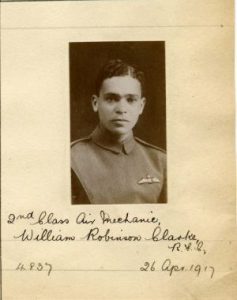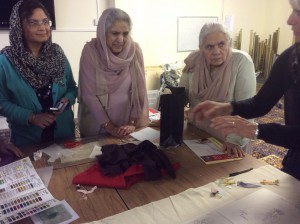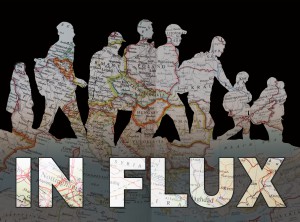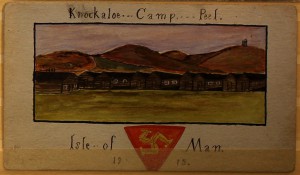We Will Remember Them
Lead academic Professor Sharon Monteith (Nottingham Trent University) with Professor Kurt Barling (Middlesex University) and Emeritus Professor David Killingray
Community Lead Partner: Nottingham Black Archive (NBA) with Renaissance One

This project set out to uncover narratives that strengthen the coverage of under-represented groups in relation to the centenary. Empire troops fought in the most infamous battles of the war, including at Ypres and Passchendaele, but the hidden histories of soldiers from the Caribbean and South Asia still need to be recovered and their stories told, not only in scholarly monographs but in other cultural forms too. This project therefore focuses on visual culture in the form of a travelling exhibition for the general public to ensure that we try to avoid the risk that younger generations will conceive of the war as fought entirely by white soldiers. It mines the stories of the soldiers and centres on the East Midlands. The exhibition launched on September 22nd 2017 at New Art Exchange, Nottingham, and then toured Nottingham, the East Midlands and London through October, November and December.
Sikh Tapestry Project
Lead academics: Dr Mike Heffernan, Dr Steve Legg (University of Nottingham)
Community Partner: Ramgarhia Social Sisters

The Centre supported this Leicester Sikh group as they engage with the heritage of the First World War. The group, who meet on a regular basis, developed a First World War commemorative project in the form of a tapestry that tells the story of the Sikh contribution to the war and will be based in part on their own family histories.
The Centre provided the group with a grant to fund their work. Professor Mike Heffernan acted as academic adviser, alongside Dr Steve Legg of the School of Geography, University of Nottingham, who is an expert on post-Second World War New Delhi.
In Flux

The Centre developed a partnership with Nottingham based community theatre company Excavate in order to work with a variety of organisations that support those who are seeking refuge in Nottingham, alongside a group of artists from across the Middle Eastern community in the city. Together they created an artistic response to issues of migration caused by war, and what it means to be a refugee and to resettle in another country; issues of dissolving borders in the Middle East (2016 is the centenary of the Sykes-Picot agreement that defined the borders of Iraq and Syria); and the ways in which the public’s perception of what refuge is and how it should be offered, and under what conditions, is changing.
They gathered stories and testimonies from those who are currently seeking refuge in Nottingham, those who work with these people, and those who have now established themselves in Nottingham having resettled from a range of countries across the Middle East. The group then created a performance event that will blend music, storytelling and projections/film which was performed in a number of formal and informal community spaces across the city and beyond.
Handforth
Lead academic: Dr Tim Grady (University of Chester)
Community Partner: Handforth Parish Council
This project aimed to reveal the diverse history of the prisoner of war camp, the largest in the North West of England, that once stood in the Cheshire village of Handforth and make it accessible to both an academic and community audience for the first time. It was a collaboration between Handforth Parish Council, which has responsibility for local infrastructure, and the Department of History & Archaeology at the University of Chester, which has academic specialism in the history of the First World War. Research conducted jointly by the two partners forms the basis of an innovative outreach programme.
Centred on Handforth railway station – a key commuter base – the partners displayed the history of camps on platform posters and through information leaflets. This material gave people an overview of the camp and its history but also directed them to more detailed online information, accessible by scanning QR codes on the posters and leaflets. These community activities not only helped to return the camp to the local memory culture, but also ensured that the people of Handforth have a greater understanding of the diverse range of people that once inhabited their village.
Belgians in Cheshire
Lead Academic: Dr Hannah Ewence (University of Chester)
Community Partner: St Werburgh’s Catholic Church
This project made a case study of the reception of Belgian refugees in the county of Cheshire. In contrast to the dominate narrative of the county, both historically and today, as culturally and demographically homogeneous, it suggested that the widespread presence of Belgian refugees in all corners of the county is just one, of many, hidden histories that challenges such mis-conceptions. Working with volunteers from St Werburgh’s Catholic Church, Chester, this project drew together the threads of this rich and important but much overlooked history, by creating a travelling exhibition and a digital database of Belgians present in the county. The exhibition and database invited the people of Cheshire to reconsider their history as one deeply connected to the ebb and flow of conflict, forced migration, and asylum. By touring a variety of locations including town halls, shopping centres and the University of Chester, the exhibition also offered a unique opportunity to engage a diverse audience in this important local history. The database will cement the tangible threads of this history further still by offering a lasting and useable legacy.
Soldiers of Oxfordshire Museum
Lead Academic: Dr Tudor Georgescu (Oxford Brookes University)
Community Partner: Soldiers of Oxfordshire Museum
This project was a partnership between Soldiers of Oxfordshire Museum (SOFO) and the History, Philosophy and Religion Department of Oxford Brookes University and focuses on the theme of ‘Remembrance and Commemoration’ and the war beyond western Europe. It aimed to pursue both an original research project analysing the unused hidden histories housed in the Museum archive, and provide a series of methodological and skills based workshops for the Museum’s volunteers. The research focus lay with the investigation of the holdings relating to the war beyond the Western Front, including East European, Balkan, and Middle Eastern theatres.
The partnership assessed the extent to which the SOFO archive can bring a wider understanding of the war beyond the western front to its communities for the first time. The project presented its findings both academically – assessing the historical and museological value of the material – and also represent the historical outcomes to its communities in the form of a publication relating to the First World War commemorations.
Hidden Strangers
Lead Academics: Dr Natalie Braber and Professor Bill Niven (Nottingham Trent University)
Community Partner: Pomegranate Youth Theatre
Playwright: Louise Page
This project explored the relationship between anti-German propaganda and violence against German citizens living in the East Midlands during the First World War through a combination of research and the writing and performance of a play with a local youth theatre. The play examined how the spread of anti-German feeling was experienced by members of the German diaspora in Britain. In Chesterfield and the surrounding area, for example, German butchers had their shops stoned and windows broken in response to the sinking of the Lusitania in May 1915. Germans who had been living in the UK for many years, some who had come to escape persecution in Germany, lost their jobs, were arrested and interned and suffered discrimination. This side of WW1 is not frequently remembered or discussed when looking at this period in time. Anti-German propaganda was rife and aspects of such discrimination continues in the UK today with treatment of refugees and asylum seekers. This project worked with a Chesterfield youth theatre group to examine what life was like for such Germans and how this can inform us about prejudice and discrimination more generally. The participants in the youth group were co-producers of the work and the performance encouraged interaction with a wide audience to discuss these themes.
Derby Green Spaces
Lead Academics: Professor Paul Elliott and Mark Knight (University of Derby)
Community Partners: Spiral Arts and Derbyshire Lives Through the First World War
By the outbreak of war in 1914, most British towns had at least one significant public park and like other public institutions, these were caught up in some of the reactions and ambiguities of the home front, and were utilised both in support of the war effort in various ways. Parks were employed as places of recruitment for the armed forces, and with casualties, food shortages, rationing and in some cases direct enemy attacks such as Zeppelin and aeroplane bombings, the war impacted upon them in various ways. They were also requisitioned for various purposes including military (such as anti- Zeppelin and aircraft guns), defensive, governmental, medical and for food production, particularly after the Defence of the Realm Act or (DORA) was passed in August 1914. They helped maintain morale when some other forms of recreation were curtailed, were places where civilian and military populations on leave or recuperating could temporarily escape from some of the demands of war and even resist authority and sometimes served as venues for anti-war and pacifist meetings and demonstrations too. Finally, parks served as places of memorialisation.
This project aimed to investigate how much these development were replicated in Derby’s public parks during the War and its immediate aftermath, and to present the research results in an artistically imaginative way (including a banner) with community co-production. It was led by Spiral Arts, a visual artistic group with considerable experience of working with community groups on similar projects who are based in the Derby Arboretum, assisted by Mark Knight a history PhD student at Derby University and Paul Elliott, a history academic, with advice from Glynn Wilton of the Heritage Lottery-funded Derbyshire Lives Through the First World War project.
Middlesex Regiment
Lead Academic: Professor Kurt Barling (Middlesex University)
Community Partner: Eastside Community Heritage

The Middlesex Regiment was one of the principal regiments based in the Home Counties. It recruited from a wide-cross section of society from the Public Schools battalions to football team like Tottenham Hotspur. It was a regiment with a long and proud history. During the Great War many recruits came from the Old Commonwealth Dominions and elsewhere in the British Empire. Battalions were sent to India in 1911 and fought right across the Western Front from January 1915. The battlefield cemeteries of France and Belgium house tens of thousands of Middlesex Regiment fallen.
This project was a collaboration between Middlesex University and Eastside Community Heritage that emerged from a Heritage Lottery Fund project to train new researchers (undergraduates and volunteers) to work in public archives to build up the stories of up to 20 soldiers who came from outside these islands to fight. These new researchers undertook training and developed skills in archive research, oral history telling and working in museum spaces to curate an exhibition at Bruce Castle Museum in Tottenham, North London.
The team created materials for a pop-up exhibition and pack so that schools with particularly diverse student populations can use the material as teaching aids. They established a network of schools to engage with and plan to use existing resources through the Widening Participation department at Middlesex and links with the Bruce Castle Museum schools programme.
Original video interviews with descendants of WW1 soldiers have been been gathered for use in a short documentary that became part of the education package with the pop-up exhibition. A symposium took place in 2016 to use these materials to discuss building networks and sharing methodologies to build on public engagement and impact work.
Britalians
Lead Academic: Dr Robert Hearn (University of Nottingham)
Community Partner: Honorary Consul of Italy in Nottingham
This project explored the memories and commemoration of the conflict amongst Italians in the East Midlands by way of a large-scale oral history project co-conducted by researchers at the University of Nottingham and partners in the British Italian community. This unique research project aimed to make a series of contributions to explorations into the ‘hidden histories’ of the experience and memory of World War One amongst migrant groups in the UK, seeking to challenge traditional narratives surrounding the conflict.
The empirical data was co-collected by academic and community partners in order to assure the mutual acquisition of new skills, training and insights. The data collected informed articles to be published in scholarly journals and papers presented to diverse local and national audiences, alongside the analysis of the experiences gained from the academic-community partnership.
Knockaloe in Local, National and Global Context
Lead Academic: Professor Panikos Panayi (De Montfort University)
Community Partner: Knockaloe Internment Camp & Patrick Visitor Centre, Isle of Man
 Knockaloe, an internment camp on the Isle of Man, is a permanent site of memory for the 30,000+ internees, as well as the 5,000+ guards, who moved into their village 100 years ago. Knockaloe became the most important site of internment in the British Empire and perhaps in the entire world during WW1. This project is the first genuine effort to commemorate the site that housed Germans, Austro-Hungarian and Ottoman citizens from all over the world.
Knockaloe, an internment camp on the Isle of Man, is a permanent site of memory for the 30,000+ internees, as well as the 5,000+ guards, who moved into their village 100 years ago. Knockaloe became the most important site of internment in the British Empire and perhaps in the entire world during WW1. This project is the first genuine effort to commemorate the site that housed Germans, Austro-Hungarian and Ottoman citizens from all over the world.
A Registered Charity has been set up by the local community of Patrick Village to develop a Visitors’ Centre in the historic Patrick Schoolroom and to create a database archive of the internees who passed through Knockaloe. This project sought to extend this database to bring together in one location information on all ‘enemy aliens’ resident in Britain in 1914, the majority of which spent some time in Knockaloe, bringing into one location the fragmentary information from worldwide museums, archives, ancestry databases and private collections and, most importantly, from the descendants themselves.
This work moves away from the traditional Armistice Day celebrations by focusing upon the enemy populations in Britain, which totalled over 60,000 people at the outbreak of the Great War, especially by concentrating upon the main site of both British and imperial internment. By focusing especially upon the experiences of enemy aliens, the project helped to demonstrate the diversity of experiences in Britain during the Great War, which did not simply mean service on the western front or ‘useful’ wartime employment, but could also mean incarceration of individuals who had lived in Great Britain for decades.
In demonstrating both the national and international origins of the internees, some of whom faced arrest in the German and British Empires, as well as on the high seas, therefore placing the Knockaloe camp in international context, the project helped to demonstrate the global nature of the First World War. It showed how the worldwide voluntary migration which had helped to create the German and other migrant communities in the late nineteenth and early twentieth centuries turned to one of forced migration, both within Great Britain and from further afield, as migrants faced relocation not just on the Isle of Man but in internment camps run by the British imperial authorities throughout the world.
The project also demonstrated how connected communities can become disconnected as a result of the intolerance caused by the nationalistic hatred which evolved during the First World War which meant that integrated Germans who had often married Britons and who, in some cases, had sons serving with British forces on the Western Front and elsewhere, became marginalised to the extent that public opinion and government felt that they needed separation form the ethnic majority through internment
Pingback: Impact: Reflection Workshop with Community Partners at Edin’s Cafe, Nottingham – The Centre for Hidden Histories
Pingback: Impact: Heritage Open Day 2016 at Lofthouse, Yorkshire – The Centre for Hidden Histories
Pingback: Homepage